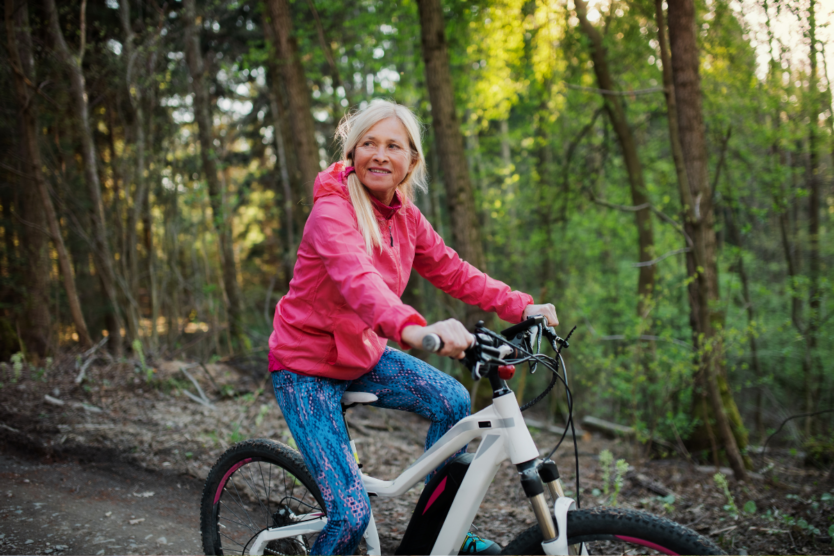We’ve all heard of muscle-specific exercises, like curls for your biceps or squats for your quads and hamstrings. Aerobic activity is good for the heart and lungs.
What about your bladder? Does physical activity benefit your bladder? If so, what type of exercise is good for the bladder?
Let’s explore the impact of physical activity on bladder health.
The Benefits of Exercise
It’s no secret that physical activity is known to improve overall health. Exercise can help you feel better and have more energy, and may even add years to your life.1 Everyone of every age can benefit from some form of physical activity.
Here are a few ways exercise is good for you:1
- It may help control weight.
- It can combat health conditions and diseases like high blood pressure, stroke, type 2 diabetes, depression, anxiety, many types of cancer, arthritis and falls, to name a few.
- It can improve your mood.
- It will boost your energy.
- Exercise promotes better sleep.
- It can put the spark back into your sex life.
- It can be fun and increase social activity.
Physical activity doesn’t have to mean going to the gym for a vigorous workout every day. A dance class, hiking, or a walk are all ways to exercise. Choose something you enjoy, try something new, or do an activity with friends or family.
It is recommended that you engage in some type of moderate aerobic activity, with 150 minutes a week being a general guideline. It’s also recommended to do strength training for your major muscle groups at least twice a week.1
What about your bladder? How can exercise help your bladder? What if your bladder is a deterrent to exercise?
Physical activity and bladder health are actually very connected. Let’s find out more.
The Impact of Physical Activity on Bladder Health
Aerobic exercise will obviously help your cardiovascular system and strength training improves the muscle groups involved, but exercise is beneficial to other parts of your body too.
Did you know that if you exercise, your bladder health will improve?
Besides enhancing your entire body’s health, here are other ways that physical activity can improve your bladder health specifically:2
- Strengthening the pelvic muscles which support the bladder and urethra (more on that later).
- Keeping the bladder muscle, known as the detrusor, functioning properly. That allows your bladder to fill and empty properly.
- Decreasing the chance of constipation, which can increase the frequency and urgency of urination. Chronic constipation can also lead to urinary incontinence.
- Increasing your blood flow and circulation. This helps your kidney filter properly and eliminate waste in the body. Increased blood flow also brings more oxygen-rich blood to your vital organs—including your bladder—which promotes their health.
- Maintaining sexual function.
If your bladder health is poor, you may suffer from conditions like leaking urine when you exercise. This is known as urinary incontinence, or UI, and it impacts a quarter to a third of men and women in the United States—or millions of Americans. As well, about 33 million people have overactive bladder, or OAB, which is when you have symptoms of urgency and frequency to pee, and may also have urge incontinence.3
This can become a vicious cycle, as women with these conditions exercise less, or don’t exercise at all, because they’re afraid of urine leaking. For instance, one study reported that women feel ashamed that urine leakage occurs when doing physical activity.
UI is associated with a lower level of physical activity, and these women are then deprived of the many benefits physical activity can provide in preventing and dealing with different conditions and diseases.4
Even in the most severe cases, such as in those suffering from bladder cancer, physical activity is beneficial. One study reported that approximately 1 in 3 bladder cancer patients were sedentary. Those patients who were active were less likely to report that they had poor physical health. The study concluded that starting exercise programs for bladder cancer patients could be promising in improving their health status.5
Exercise for Bladder Health
Any type of physical activity can provide health benefits, but there are exercises that can specifically boost the well-being of your bladder.
Conditions like UI and OAB (which often includes incontinence) are most often the result of weakened pelvic floor muscles. Your pelvic floor is the hammock-like structure of muscles and ligaments that support and control your pelvic organs, including your bowel and bladder. Weak muscles create problems with bladder and bowel control.
One of the best ways to enhance your pelvic health, prevent issues like UI, or treat UI if you have it, is by strengthening your pelvic floor muscles by performing Kegel exercises.
Kegels are done by contracting your pelvic floor muscles for 3 seconds and then releasing the muscles and relaxing for 3 seconds. You may want to check with a doctor or physical therapist to ensure you’ve got the correct technique, as it is important to make sure you’re exercising the proper muscles.
There are tools that can help ensure you’re doing Kegels properly, like Gynesis. Gynesis pelvic floor trainer shorts support women to take control of their pelvic health with a simple, effective, external, and accessible solution. Using advanced technology, Gynesis delivers targeted muscle stimulation with Kegel exercises that helps retrain and rebuild your pelvic floor—so you can achieve stronger bladder control and with confidence.
Research has proven that pelvic floor exercises help keep pelvic floor muscles “fit,” and can be used as an effective treatment for women suffering with stress urinary incontinence. It can also be preventative, so don’t wait until your muscles are weak before you incorporate Kegels into your exercise program. Women as young as those in their 20s can include these exercises in their regular routine.
If you are suffering from UI or OAB and are hesitant to exercise, high-impact exercise like running or jumping may make your symptoms worse. They can also create that fear of leakage that makes it hard to feel comfortable exercising. It’s also a good idea to avoid too much heavy lifting, which can be a risk factor for pelvic floor disorders because it puts strain and pressure on pelvic floor muscles.
There are low-impact options that can still allow you to remain active. Swimming, walking, and cycling are low impact enough to prevent leaks, and still provide a good cardiovascular workout. Strength training can build your muscles as well as improve posture, balance, and core strength.6
A strong core—consisting of the lower abdomen, hips, pelvis, lower back, adductors, and abductors—works with the pelvic floor muscles to help support the bladder, bowel, and reproductive organs.2
It’s vital that you don’t let symptoms of incontinence prevent you from exercising. If you do worry about leaks, there are adjustments you can make to manage incontinence and ensure you can still be active.
For instance, limit how much you drink before you workout, go to the bathroom just before exercising, and take a bathroom break during your activity while possible. There are also tools available to prevent leaks, like absorbent pads, a pessary (a vaginal insert designed to help incontinence) or a urethral insert (a small tampon-like disposable device inserted into the urethra to act as a barrier to prevent leakage).
If you do want guidance on how to do pelvic floor exercises or exercising for your core, you can also seek the advice of a pelvic floor physical therapist.
It’s important that you remain active, for your bladder health and your overall well-being.
See A Doctor
Physical activity is important to your health, so be sure to stay active to benefit your overall well being. Physical activity is also important for your bladder health. If you have symptoms of incontinence or overactive bladder, use our Physician Finder to find a doctor near you with expertise in women’s health. Get advice on an exercise program that suits you, including important pelvic floor exercises, so that you can continue to be active. Physical activity is good for your bladder health as well as your mental health.
















